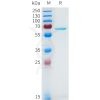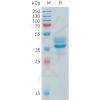| Target | |
|---|---|
| Synonyms | AKT;PKB;PKB-ALPHA;PRKBA;RAC;RAC-ALPHA |
| Description | Recombinant Human AKT1 Protein with C-terminal 8×His tag |
| Delivery | Under development |
| Uniprot ID | P31749 |
| Expression Host | HEK293 |
| Tag | C-8×His Tag |
| Molecular Characterization | AKT1(Met1-Ala480) 8×His tag |
| Molecular Weight | The protein has a predicted molecular mass of 56.8 kDa after removal of the signal peptide. The apparent molecular mass of AKT1-8xHis is approximately 55-70 kDa due to glycosylation. |
| Purity | The purity of the protein is greater than 85% as determined by SDS-PAGE and Coomassie blue staining. |
| Formulation & Reconstitution | Lyophilized from sterile PBS, pH 7.4. Normally 5 % – 8% trehalose is added as protectants before lyophilization. Please see Certificate of Analysis for specific instructions of reconstitution. |
| Storage & Shipping | Store at -20°C to -80°C for 12 months in lyophilized form. After reconstitution, if not intended for use within a month, aliquot and store at -80°C (Avoid repeated freezing and thawing). Lyophilized proteins are shipped at ambient temperature. |
| Background | This gene encodes one of the three members of the human AKT serine-threonine protein kinase family which are often referred to as protein kinase B alpha, beta, and gamma. These highly similar AKT proteins all have an N-terminal pleckstrin homology domain, a serine/threonine-specific kinase domain and a C-terminal regulatory domain. These proteins are phosphorylated by phosphoinositide 3-kinase (PI3K). AKT/PI3K forms a key component of many signalling pathways that involve the binding of membrane-bound ligands such as receptor tyrosine kinases, G-protein coupled receptors, and integrin-linked kinase. These AKT proteins therefore regulate a wide variety of cellular functions including cell proliferation, survival, metabolism, and angiogenesis in both normal and malignant cells. AKT proteins are recruited to the cell membrane by phosphatidylinositol 3,4,5-trisphosphate (PIP3) after phosphorylation of phosphatidylinositol 4,5-bisphosphate (PIP2) by PI3K. Subsequent phosphorylation of both threonine residue 308 and serine residue 473 is required for full activation of the AKT1 protein encoded by this gene. Phosphorylation of additional residues also occurs, for example, in response to insulin growth factor-1 and epidermal growth factor. Protein phosphatases act as negative regulators of AKT proteins by dephosphorylating AKT or PIP3. The PI3K/AKT signalling pathway is crucial for tumor cell survival. Survival factors can suppress apoptosis in a transcription-independent manner by activating AKT1 which then phosphorylates and inactivates components of the apoptotic machinery. AKT proteins also participate in the mammalian target of rapamycin (mTOR) signalling pathway which controls the assembly of the eukaryotic translation initiation factor 4F (eIF4E) complex and this pathway, in addition to responding to extracellular signals from growth factors and cytokines, is disregulated in many cancers. Mutations in this gene are associated with multiple types of cancer and excessive tissue growth including Proteus syndrome and Cowden syndrome 6, and breast, colorectal, and ovarian cancers. Multiple alternatively spliced transcript variants have been found for this gene. [provided by RefSeq, Jul 2020] |
| Usage | Research use only |
| Conjugate | Unconjugated |

Human AKT1 Protein, His Tag
Price: 10μg ¥782.00 ; 50μg ¥2866.00 ; 100 μg ¥4299.00
Product Data Dima FAQ
图片 Dima FAQ
相关产品
ECD Proteins
SKU: PME101645 Target: AKT1
Price: 10μg ¥706.00 ; 50μg ¥2500.00 ; 100μg ¥3699.00
ECD Proteins
SKU: PME101553 Target: AKT1
Price: 10μg ¥690.00 ; 50μg ¥2500.00 ; 100μg ¥3699.00


